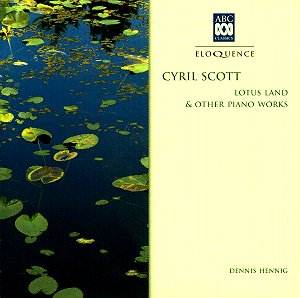Dennis Hennigís sleeve note contains an introductory
paragraph succinct in setting out the Scott dilemma Ė member of the
Frankfurt Group, hailed as progressive saviour of British modernism
in his early twenties, followed by the rapid decline of his reputation
after the First World War. Hennigís disc first appeared on Etcetera
and was issued in 1992. It is a generous and in some ways absorbingly
troubling selection of works written within an eleven year period which
range from salon morceaux through Pictorialism to the more obvious fires
and fissures of the 1909 Sonata.
Lotus Land, still the paradigmatic Scott
composition, opens the recital coupled with its less well-known opus
mate, Columbine. Both are examples of salon pictorial exotica
spiced with a dash of Ravel. The two Pierrot Pieces were inspired by
Graingerís A Lot of Rot for cello and piano which Scott claimed
had "caught something of the sad sentimental vulgarity of the music
hall." Scottís own double tribute, both to Grainger and to the
variety stage, is a rather more earthbound affair. The chordal progressions
of Pierrot triste strike me as melodramatically pat and wistful,
in the worst sense; melodically it strikes me as a cross between Nessum
Dorma and the Londonderry Air. We reach deeper waters with
the five Poems of 1912. The poems are all by Scott and this is
attractively sensuous, harmonically versatile music with its aphoristic
beauties intact. Employing chains of parallel fourths and sixths in
imitation of bells tolling Scott is both Debussyian and also highly
personalised in his inspiration. The bell tolling of the central
piece is both authentic in sound and curiously moving, the set as a
whole a marriage of technique and a sophisticated means of expression.
Especially attractive as well is the central Danse Orientale
from the 1910 Trois Danses tristes. It is dedicated to Maud Roosevelt,
a close friend of Scottís and whilst still, perhaps, salon in impulse
has an assertive-reflective life of its own in his best "eastern"
style (Scott had famously never been to any of places whose music he
evoked).
The Sonata adopts Graingerís free rhythm and also employs
unequal bar lengths and is a cyclic and a substantial work ending in
a distinctly unGraingerian fugal passage. Itís the first of his three
piano sonatas (the others date from 1932 and 1956) and has a convulsively
attractive, errant harmony. Itís often assertive, freely associative
melodically and embeds distinctive folk material into its fabric, exploring
moods and impressions with a sometimes aggressive eloquence. The slow
section, a six minute adagio, is especially compelling but the whole
work is a distinctive achievement and a fitting end to Henningís very
well played recital tracing as it does the twin poles of Scottís creative
life, from the hot house of Lotus Land to the tough formalities
of the Sonata. Strongly recommended.
Jonathan Woolf


